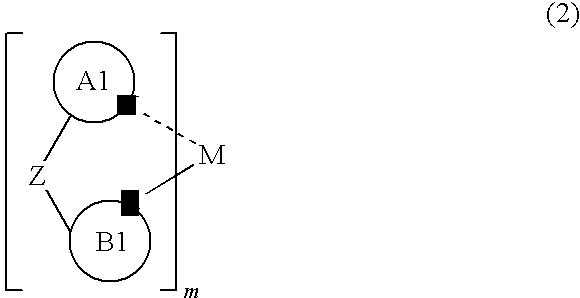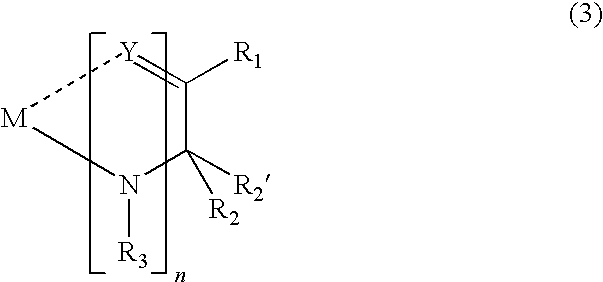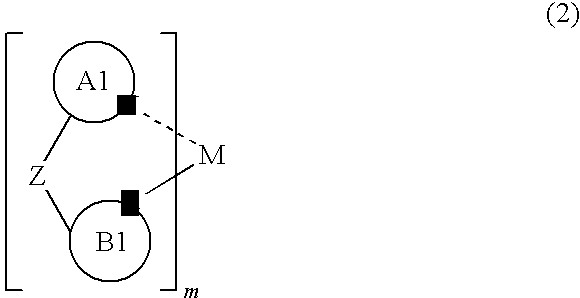Metal complex compound and organic electroluminescent element using the same
a technology of metal complex compound and organic electroluminescent element, which is applied in the direction of solid-state device, discharge tube/lamp details, indium organic compound, etc., can solve the problem of extremely poor heat resistance and achieve the effect of long life and high light emission efficiency
- Summary
- Abstract
- Description
- Claims
- Application Information
AI Technical Summary
Benefits of technology
Problems solved by technology
Method used
Image
Examples
synthesis example 1
[0143]
Synthesis of Compound (A1)
[0144]2.00 g of iridium chloro-bridged dimer A, 0.34 g of 2-acetylpyrrole, 1.7 g of sodium carbonate and 50 ml of 2-ethoxyethanol were placed in a three neck flask of 200 ml, followed by the argon gas displacement, and the resultant was refluxed under heating for 10 hours while stirring. The resultant was cooled to a room temperature, followed by filtration. The obtained-solid substance was added dichloromethane and water, followed by dichloromethane extraction. The organic solvent layer was dried with the use of sodium sulfate anhydride, followed by evaporation. The obtained was purified with 100 g of silica gel column chromatography and as a result, slightly yellow colored solid of 2.0 g was obtained. Further, it was purified by sublimation under the vacuum of 50×10−6 Torr at 250 degC, and 1.93 g of the compound (A1) was obtained. The structure was identified by FD-MS measurement (Field Desorption Mass Spectrometry). The result of the measurement is...
synthesis example 2
[0146]
Synthesis of Compound (4)
[0147]2.40 g of iridium chloro-bridged dimer B, 0.36 g of 2-acetylpyrrole, 1.60 g of sodium carbonate and 50 ml of 2-ethoxyethanol were placed in a three neck flask of 200 ml, followed by the argon gas displacement, and the resultant was refluxed under heating for 9 hours while stirring. The resultant was cooled to a room temperature, followed by filtration. The obtained-solid substance was added dichloromethane and water, followed by dichloromethane extraction. The organic layer was dried with the use of sodium sulfate anhydride, followed by evaporation. The obtained was purified with 100 g of si ca gel column chromatography and as a result, slightly yellow colored solid of 1.75 g was obtained. Further, it was purified by sublimation under the vacuum of 4.0×10−6 Torr at 280 deg C., and 1.41 g of the compound (A4) was obtained. The structure was identified by FD-MS measurement. The result of THE measurement is shown as follows:
[0148]FD-MS: calcd. for I...
synthesis example 3
[0149]
Synthesis of Compound (A12)
[0150]2.20 g of iridium chloro-bridged dimer B, 0.42 g of 2-acetyl-5-methylpyrrole, 1.60 g of sodium carbonate and 50 ml of 2-ethoxyethanol were placed in a three neck flask of 200 ml, followed by the argon gas displacement, and the resultant was refluxed under heating for 16 hours while stirring. The resultant was cooled to a room temperature, followed by filtration. The obtained-solid substance was added dichloromethane and water, followed by dichloromethane extraction. The organic layer was dried with the use of sodium sulfate anhydride, followed by evaporation. The obtained was purified with 100 g of silica gel column chromatography and as a result, slightly yellow colored solid of 1.60 g was obtained. Further, it was purified by sublimation under the vacuum of 3.6×10−6 Torr at 260 deg C., and 1.38 g of the compound (A12) was obtained. The structure was identified by FD-MS measurement. The result of the measurement is shown as follows:
[0151]FD-MS...
PUM
| Property | Measurement | Unit |
|---|---|---|
| external quantum efficiency | aaaaa | aaaaa |
| work function | aaaaa | aaaaa |
| work function | aaaaa | aaaaa |
Abstract
Description
Claims
Application Information
 Login to View More
Login to View More - R&D
- Intellectual Property
- Life Sciences
- Materials
- Tech Scout
- Unparalleled Data Quality
- Higher Quality Content
- 60% Fewer Hallucinations
Browse by: Latest US Patents, China's latest patents, Technical Efficacy Thesaurus, Application Domain, Technology Topic, Popular Technical Reports.
© 2025 PatSnap. All rights reserved.Legal|Privacy policy|Modern Slavery Act Transparency Statement|Sitemap|About US| Contact US: help@patsnap.com



